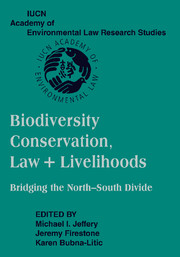 Biodiversity Conservation, Law and Livelihoods: Bridging the North-South Divide
Biodiversity Conservation, Law and Livelihoods: Bridging the North-South Divide Book contents
- Frontmatter
- Contents
- Acknowledgments
- Message from Kofi A. Annan, Secretary-General of the United Nations
- Macquarie Statement
- Contributors
- Introduction
- PART ONE THE CONTEXT
- PART TWO BIODIVERSITY: ITS CONSERVATION
- 5 Biodiversity Conservation in the Context of Sustainable Human Development: A Call to Action
- 6 Legal and Paralegal Rules for Biodiversity Conservation: A Sequence of Conceptual, Linguistic, and Legal Problems
- 7 Future Directions in Conservation of Biological Diversity: An Interdisciplinary Approach
- 8 Experience, Mistakes, and Challenges: The Implementation of the Convention on Biological Diversity in Brazil
- 9 EC Law and Biodiversity
- 10 Community-Based Biodiversity Conservation in the Pacific: Cautionary Lessons in “Regionalising” Environmental Governance
- PART THREE CONSERVATION MEASURES
- PART FOUR USES OF COMPONENTS OF BIODIVERSITY
- PART FIVE PROCESSES AFFECTING BIODIVERSITY
- PART SIX BIOSECURITY ISSUES
- PART SEVEN ACCESS AND BENEFIT-SHARING
- Index
6 - Legal and Paralegal Rules for Biodiversity Conservation: A Sequence of Conceptual, Linguistic, and Legal Problems
Published online by Cambridge University Press: 31 July 2009
- Frontmatter
- Contents
- Acknowledgments
- Message from Kofi A. Annan, Secretary-General of the United Nations
- Macquarie Statement
- Contributors
- Introduction
- PART ONE THE CONTEXT
- PART TWO BIODIVERSITY: ITS CONSERVATION
- 5 Biodiversity Conservation in the Context of Sustainable Human Development: A Call to Action
- 6 Legal and Paralegal Rules for Biodiversity Conservation: A Sequence of Conceptual, Linguistic, and Legal Problems
- 7 Future Directions in Conservation of Biological Diversity: An Interdisciplinary Approach
- 8 Experience, Mistakes, and Challenges: The Implementation of the Convention on Biological Diversity in Brazil
- 9 EC Law and Biodiversity
- 10 Community-Based Biodiversity Conservation in the Pacific: Cautionary Lessons in “Regionalising” Environmental Governance
- PART THREE CONSERVATION MEASURES
- PART FOUR USES OF COMPONENTS OF BIODIVERSITY
- PART FIVE PROCESSES AFFECTING BIODIVERSITY
- PART SIX BIOSECURITY ISSUES
- PART SEVEN ACCESS AND BENEFIT-SHARING
- Index
Summary
INTRODUCTION
The enforceability and hence effectiveness of environmental law depends to some extent on the language used to express its rules. Apart from environment itself, such words include protection, conservation, enhancement, improvement, utilisation, precaution, sustainability, equity, heritage, nature, and, of course, biological diversity (hereafter biodiversity). Words such as these perform different functions. Some are descriptive; a few state objectives; a number describe processes and procedures; some state values. Perhaps the function of some is unclear. Often, however, the way in which words are used, their relationship with other words and the context of their use illuminate their meaning and the part they play in the system that comprises the rules of environmental law. So it is with the conservation of biodiversity.
The conservation of biodiversity – which is part of the natural and cultural environment – together with the protection of the environment from harm are merely two of the essential elements of the concept of sustainability. Although sustainable development drives much of contemporary environmental law, it is by no means certain what are its functions and its status within the legal system. As we shall see, sustainable development is in some respects an outcome to be achieved by the detailed methodology of decision making prescribed by the legal system. How this is incorporated within the legal system is an ongoing challenge. Despite a significant number of responses to this challenge, there is no clear or consistent doctrinal approach from the perspective of the law.
- Type
- Chapter
- Information
- Biodiversity Conservation, Law and Livelihoods: Bridging the North-South DivideIUCN Academy of Environmental Law Research Studies, pp. 94 - 131Publisher: Cambridge University PressPrint publication year: 2008
